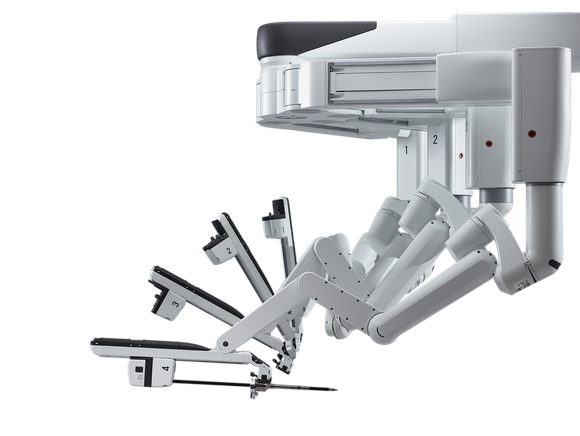Normally, Intuitive Surgical Inc. (ISRG +1.87%) -- maker of the da Vinci robotic surgical system -- can count on international procedure growth to far outpace domestic progress. Recently, however, that hasn't been the case. While international operations still grew faster (18%) than domestic ones (14%), the gap has narrowed considerably.
Shareholders, however, have little to worry about. Not only are the international headwinds likely temporary, but U.S. growth -- building off a much stronger base -- has been very healthy lately, and it shows no signs of slowing down.

Image source: Intuitive Surgical.
Intuitive earnings: The raw numbers
Before we dive into the specifics, let's take a look at the headline numbers for the company:
| Metric | Q1 2018 | Q1 2017 | Growth |
| Revenue | $848 million | $680 million | 25% |
| EPS* | $2.44 | $1.71 | 43% |
Data source: Intuitive Surgical. *EPS is non-GAAP.
It should be noted that revenue growth was artificially bolstered by the fact that Intuitive deferred $23 million in revenue one year ago to account for trade-ins; the company had just released its newest model. Intuitive also benefited from favorable currency tailwinds. If we back those two considerations out, Intuitive's revenue growth would have clocked in at about 19%.
That being said, the results were still impressive. Perhaps most important to long-term investors, the company is winning over new customers without needing to step up spending on its sales force -- which jumped just 9%, versus the 25% revenue growth. The combination of Intuitive's ubiquity -- it now has over 4,500 systems placed worldwide -- and repeat customers means that sales are becoming higher margin in nature.
Here's how the company performed when broken down by major segments:
| Division | Q1 2018 | Q1 2017 | Growth |
| Instruments | $460 million | $381 million | 21% |
| Systems | $235 million | $161 million | 46% |
| Services | $153 million | $138 million | 11% |
Data source: Intuitive Surgical.
Again, the systems results are somewhat inflated because of the $23 million deferral last year. Backing that out, though, growth in the segment would have still been impressive: up 28% year over year.
That strength came because the company placed 185 new da Vinci surgical systems during the quarter, up 39%. Those placements skewed more heavily toward domestic customers (112 total). But international placements -- working off a smaller base -- actually doubled, with 45 total systems being placed in Europe, nine in Japan, and the remaining 19 spread out across the rest of the globe.
Procedure growth remains strong
But as important as all those figures are, none deserve more attention from long-term shareholders than the company's 15% procedure growth during the quarter. Starting out the year, management's forecast called for 11% to 15% growth -- and after the first quarter's showing, that range narrowed upward: It now calls for procedure growth between 12% and 15%.
On the conference call, Intuitive's CEO, Dr. Gary Guthart, Ph.D., said:
"Underpinning this growth was increased use of da Vinci in general surgery in the United States, continued growth in urology in Europe and Asia, and multispecialty growth in China. General surgery growth was led by hernia repair and colon resection."
All of this is worth noting. Hernia repairs have been paramount to the company for a few years now, but there are other procedures emerging that underscore the key thesis to investing in Intuitive: the possibility, over time, of ever more procedures benefiting from robotic surgery thanks to tinkering by doctors. These include:
- Colorectal procedures in the United States.
- Bariatric procedures in the United States.
- Thoracic procedures in the United States.
- Prostatectomy procedures internationally.
- Kidney cancer procedures internationally.
- Gynecological procedures internationally.
The company needs only a few of these procedures to catch on with doctors to make a meaningful difference in its results.
What else happened during the quarter?
- Twelve procedures in Japan were granted permission for reimbursement.
- After receiving feedback from the Food and Drug Administration, the company's SinglePort machine is still expected to launch in 2018.
- Management submitted an application for a new 60-millimeter surgical stapler.
For the second quarter in a row, Dr. Guthart also forecast an increasingly crowded field in robotic surgery, saying, "This opportunity to improve surgery using advanced technologies is now being recognized broadly, particularly in the past several years, and we anticipate the entry of additional systems by competitors into some regions of the world over the next several quarters."
Looking ahead, the only real change to the company's 2018 forecast was the upward narrowing of procedure growth to a midpoint of 13.5% for the year.
